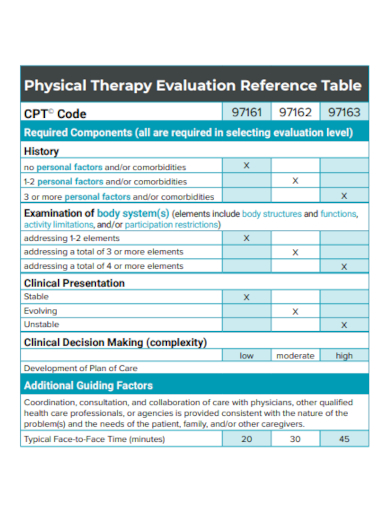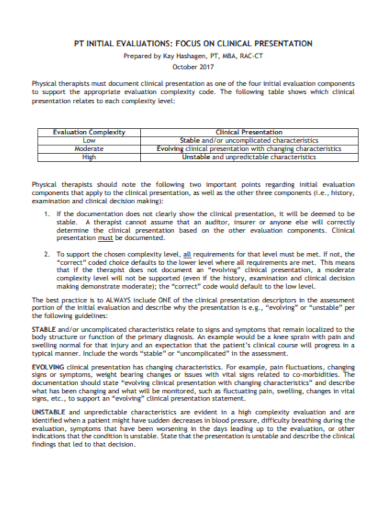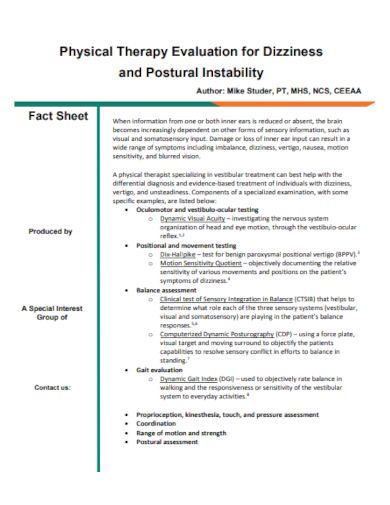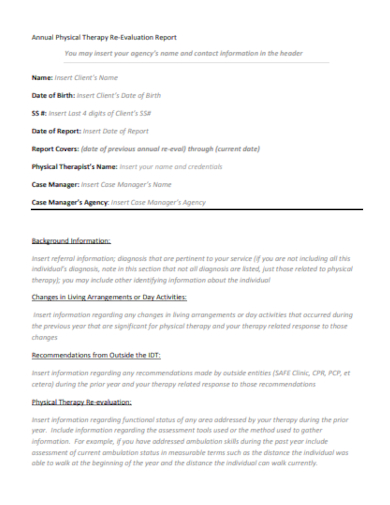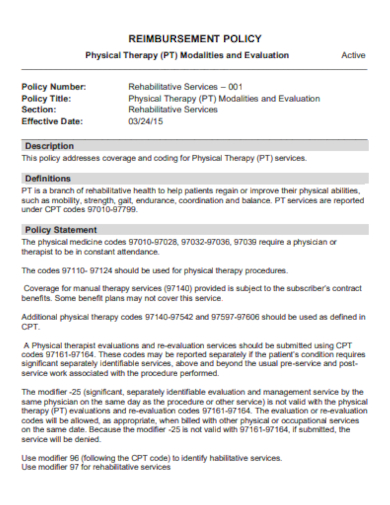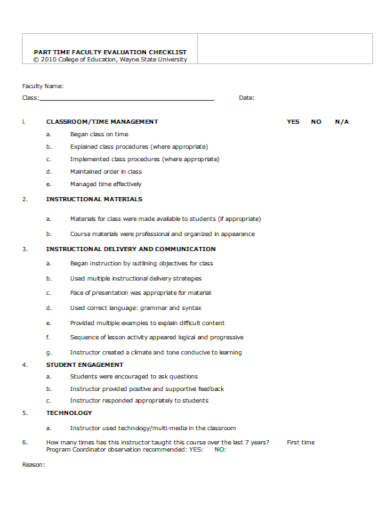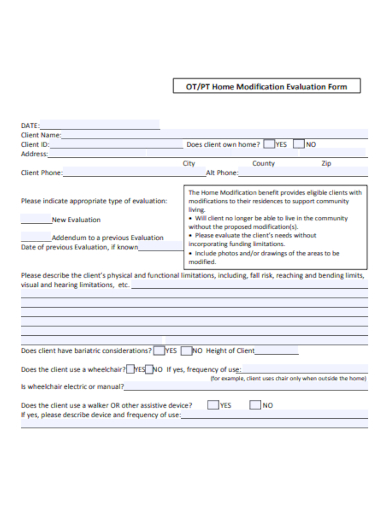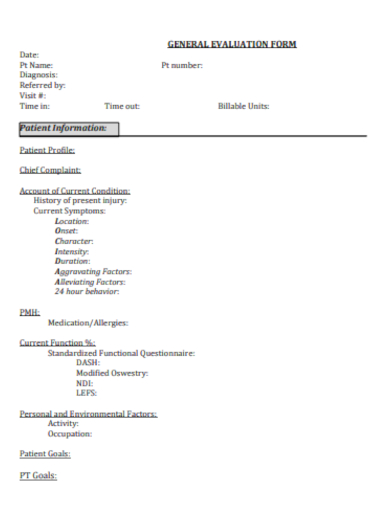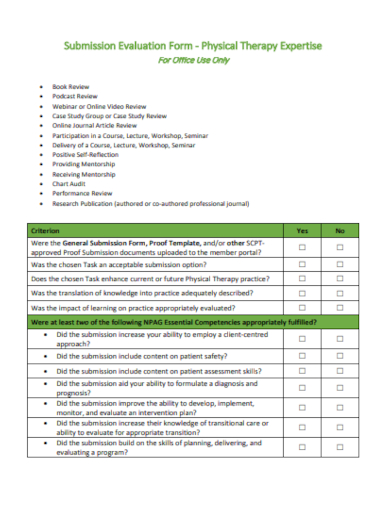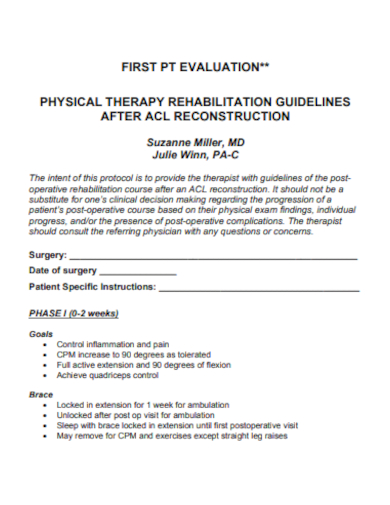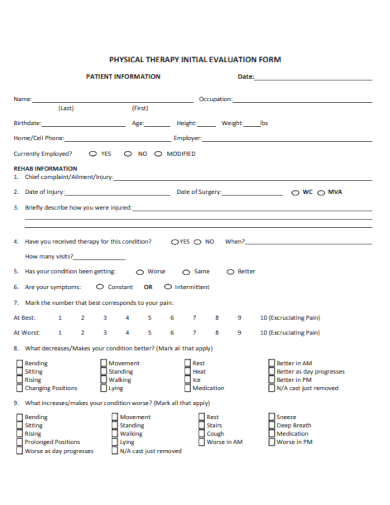When an individual suffers from an injury or illness that causes them pain or difficulty with their functional mobility, they can benefit from the skilled and professional services of an experienced physical therapist. Physical therapists perform an analysis of a specific patient’s situation and provide them with exclusive treatment plans and action plans to help them return to their normal level of functional mobility. They will start with an initial evaluation where they’ll spend time learning about the patient’s condition, previous level of function, and how it affects their daily life.
FREE 10+ PT Evaluation Samples
1. Physical Therapy Evaluation Table
2. PT Initial Evaluation
3. PT Evaluation for Instability
4. Annual PT Re-Evaluation Report
5. PT Evaluation Reimbursement Policy
6. Evaluation Form for PT Faculty
7. PT Home Modification Evaluation Form
8. PT Goals Evaluation Form
9. PT Submission Evaluation Form
10. PT Rehabilitation Evaluation
11. PT Initial Evaluation Form
What is a PT Evaluation?
Physical therapy or PT evaluation is a process that incorporates all information or data a therapist has gathered during a patient’s examination. This process is the first encounter of the therapist with a patient and sets their expectations for their healthcare plan or the estimated time when a therapist will be seeing the patient. A physical therapy evaluation will be documented and will become part of a patient’s medical record with valuable notes from every visit with the therapist.
How to Write a PT Evaluation?
With a PT evaluation, physical therapists can provide their patients with the appropriate assessment and treatment plan that can help them improve their mobility. A physical therapist performs evaluations and formal assessments to know their patient’s body and its condition. They also perform a careful movement screening and employ manual techniques to understand the patient’s body and determine what kind of treatment it needs.
Step 1: Prepare an Initial Introduction with the Patient
The first impression affects the mood of the entire session for every patient. As a therapist, it is important to put your patient at ease with appropriate wording and phrasing. You do not have to list and write down each question you plan to ask your patient but you should be able to converse with them casually as you explain their treatment plan.
Stpe 2: Inquire about their Medical History
The patient’s medical history is one of the first things that a physical therapy evaluation should cover. As their therapist, you should be knowledgeable of your patient’s medical history. Ask direct and relevant questions about their medical history and the reason they are seeking physical therapy.
Step 3: Utilize Various Special Tests and Measurement Tools
As you proceed through the examination process, you will be using a variety of special tests and measurements tools for your data collection on the patient, ranging from Range of Motion or ROM to Manual Muscle Testing or MMT and neuro screening tests, which will able you to design exclusive exams for each of your patient.
Step 4: Present the Findings and Recommend a Treatment Plan
After collecting and assessing the information you have gathered, you will be able to understand the main reasons that contribute to the patient’s discomfort, pain, and other functional limitations. At the end of your session with the patient, provide a list of home exercises they can do before their next visit.
FAQs
What are the factors that will be assessed in a PT evaluation?
A PT evaluation involves a step in which a patient needs to get up and move, so a therapist can evaluate their strength, range of motion, flexibility, posture, mobility, balance, coordination, skin integrity, and muscle function.
What type of therapies can be included in a treatment plan?
A therapist can choose to include a variety of activities for a patient’s recovery plan such as therapeutic modalities which include heat, ice, water, laser, electrical stimulation, dry needling, and ultrasound. They can also use massage and mobilization techniques as well as a collection of exercises.
What is included in a clinical examination?
A clinical examination is a part of an initial patient evaluation which covers the patient’s medical history, system review, tests and measures, posture and gait analysis, range of motion and muscle strength testing, special tests, home exercise prescription, goal setting, and treatment recommendations.
A physical therapy evaluation is an assessment method used by professional therapists to determine the factors that cause a patient pain and difficulty in functional mobility. This also helps them in determining the appropriate treatment plan for each type of patient, enabling them to get back to their normal lives. A physical therapy evaluation also documents each patient’s medical records along with their therapist’s notes that were taken during their sessions.
Related Posts
FREE 10+ Dependability Evaluation Samples in PDF | DOC
FREE 10+ Quantity of Work Evaluation Samples [ Employee, Self, Performance ]
FREE 10+ Heuristic Usability Evaluation Samples [ Website, Testing, Inspection ]
FREE 10+ Job Knowledge Evaluation Samples [ Employee, Skills, Self ]
FREE 10+ Consultant Performance Evaluation Samples in PDF | DOC
FREE 10+ Job Interview Evaluation Samples [ Teacher, Candidate, Performance ]
FREE 10+ Grant Proposal Evaluation Samples in PDF | DOC
FREE 10+ Faculty Performance Evaluation Samples in PDF | DOC
FREE 10+ Internship Evaluation Samples [ Supervisor, Self, Performance ]
FREE 10+ Resident Evaluation Samples [ Medical, Self, Rotation ]
FREE 10+ Dissertation Evaluation Samples [ Critical, Service, Self ]
FREE 3+ Front Desk Evaluation Samples [ Performance, Receptionist, Employee ]
FREE 10+ Vendor Performance Evaluation Samples in PDF | DOC
FREE 10+ Thesis Evaluation Samples [ Master, Defense, Project ]
FREE 10+ Student Evaluation Samples [ Teacher, Self, Performance ]

